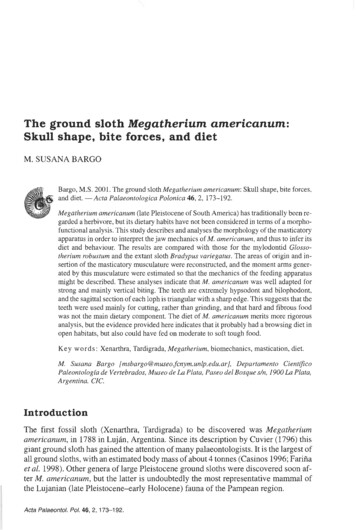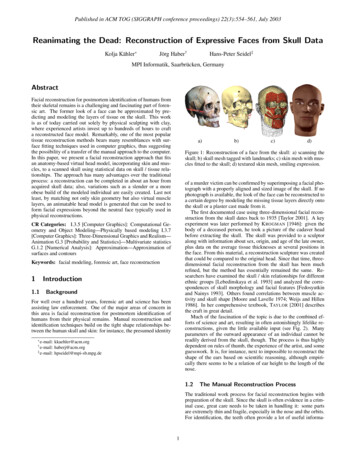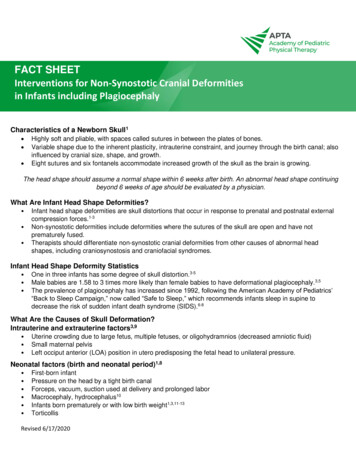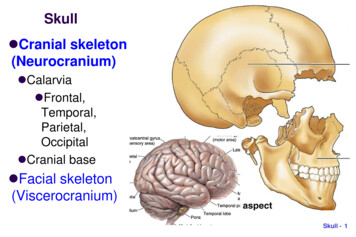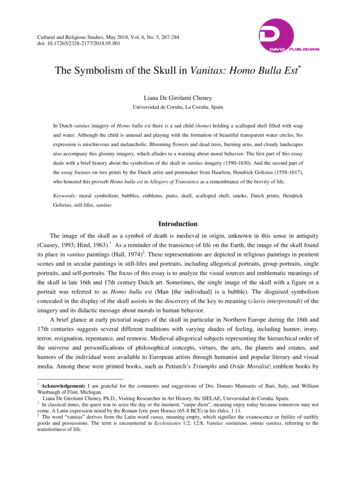
Transcription
Cultural and Religious Studies, May 2018, Vol. 6, No. 5, 267-284doi: 10.17265/2328-2177/2018.05.001DDAVIDPUBLISHINGThe Symbolism of the Skull in Vanitas: Homo Bulla Est Liana De Girolami CheneyUniversidad de Coruña, La Coruña, Spain In Dutch vanitas imagery of Homo bulla est there is a sad child (homo) holding a scalloped shell filled with soapand water. Although the child is amused and playing with the formation of beautiful transparent water circles, hisexpression is mischievous and melancholic. Blooming flowers and dead trees, burning urns, and cloudy landscapesalso accompany this gloomy imagery, which alludes to a warning about moral behavior. The first part of this essaydeals with a brief history about the symbolism of the skull in vanitas imagery (1590-1630). And the second part ofthe essay focuses on two prints by the Dutch artist and printmaker from Haarlem, Hendrick Goltzius (1558-1617),who honored this proverb Homo bulla est in Allegory of Transience as a remembrance of the brevity of life.Keywords: moral symbolism, bubbles, emblems, putto, skull, scalloped shell, smoke, Dutch prints, HendrickGoltzius, still-lifes, vanitasIntroductionThe image of the skull as a symbol of death is medieval in origin, unknown in this sense in antiquity(Causey, 1993; Hind, 1963).1 As a reminder of the transience of life on the Earth, the image of the skull foundits place in vanitas paintings (Hall, 1974)2. These representations are depicted in religious paintings in penitentscenes and in secular paintings in still-lifes and portraits, including allegorical portraits, group portraits, singleportraits, and self-portraits. The focus of this essay is to analyze the visual sources and emblematic meanings ofthe skull in late 16th and 17th century Dutch art. Sometimes, the single image of the skull with a figure or aportrait was referred to as Homo bulla est (Man [the individual] is a bubble). The disguised symbolismconcealed in the display of the skull assists in the discovery of the key to meaning (clavis interpretandi) of theimagery and its didactic message about morals in human behavior.A brief glance at early pictorial usages of the skull in particular in Northern Europe during the 16th and17th centuries suggests several different traditions with varying shades of feeling, including humor, irony,terror, resignation, repentance, and remorse. Medieval allegorical subjects representing the hierarchical order ofthe universe and personifications of philosophical concepts, virtues, the arts, the planets and estates, andhumors of the individual were available to European artists through humanist and popular literary and visualmedia. Among these were printed books, such as Petrarch’s Triumphs and Ovide Moralisé; emblem books by Acknowledgement: I am grateful for the comments and suggestions of Drs. Donato Mansueto of Bari, Italy, and WilliamWanbaugh of Flint, Michigan.Liana De Girolami Cheney, Ph.D., Visiting Researcher in Art History, the SIELAE, Universidad de Coruña, Spain.1In classical times, the quest was to seize the day or the moment, “carpe diem”, meaning enjoy today because tomorrow may notcome. A Latin expression noted by the Roman lyric poet Horace (65-8 BCE) in his Odes, 1.11.2The word “vanitas” derives from the Latin word vanus, meaning empty, which signifies the evanescence or futility of earthlygoods and possessions. The term is encountered in Ecclesiastes 1:2; 12:8, Vanitas vanitatum, omnia vanitas, referring to thetransitoriness of life.
268THE SYMBOLISM OF THE SKULL IN VANITAS: HOMO BULLA ESTAndrea Alciato, Desiderius Erasmus Roterodamus, Hadrianus Junius, Roemer Visscher, Jacob Cats, and CesareRipa; prints of antiquities (classical monuments, sculptural, and coins); and playing cards (Tarocchi) (Panofsky,1972). This kaleidoscopic medieval encyclopedia of images and meanings was associated with a humanisticatmosphere in Renaissance art, emphasizing the literary and scholastic revival of antiquity and provoking afusion of symbols with various levels of interpretations.The earliest representations of the skull in art (usually connected to a skeleton) are the totentanz or dansemacabre, ars moriendi and the dance of death, often seen in response to the mass death scenes of the BlackDeath or bubonic plagues of 1348, 1361, and 1363 (see Figures 1, 2, and 3). These illustrations portrayed themedieval idea that all human beings are equal before death. In the dance of death, individual figures asskeletons are paired with their victims as seen in Totentanz of 1455, from the Codex Platinus Germanicus 438(132r) at the University of Heidelberg in Germany (see Figure 1).The concept of pairing living figures with death continues throughout the 16th century and into the 17th inEurope.Figure 1. Totentanz, 1455, blockbook from the Codex Platinus Germanicus 438 (132r) at the University of Heidelberg,Germany (Photo credit: Public domain.commons.wikimedia.org).
THE SYMBOLISM OF THE SKULL IN VANITAS: HOMO BULLA ESTFigure 2. Master E. S., Ars Moriendi, 1464, woodcut from the Netherlandish Latin Text. Bibliothèque National ofParis (Photo credit: Public domain.wikipedia.org).Figure 3. Michael Wolgenut, Dance of Death, 1493, woodcut from the Nuremberg Chronicles (Photo credit: Publicdomain.wikipedia.org).269
270THE SYMBOLISM OF THE SKULL IN VANITAS: HOMO BULLA ESTThere is a difference between the ars moriendi and totentanz. The term ars moriendi signifies “the art ofdying” and is related to a medieval collection of texts for the use of the clergy when attending to a dying person.The totentanz or danse macabre, also differs from the dance of death, as described above. During the medievalperiod, it was believed that the dead rose from their tombs at midnight and performed a dance in a graveyardbefore setting off to claims fresh victims from the living. Eventually, in the 14th and 15th centuries in Europe,these themes of ars moriendi, danse macabre, and the dance of death―along with texts describing contestsbetween angels and demons over control of humans―were fused in the illustration tradition of woodcuts asseen in the Master E. S.’s Ars Moriendi of 1464, from the Netherlandish Latin Text, now in the BibliothèqueNational of Paris (seer Figure 2); and Michael Wolgenut’s Dance of Death from the Nuremberg Chronicles,published in 1493 (see Figure 3) (Clark, 2016; Boeckl, 1991)3. The illustrations usually show a processionmarching or dancing to a grave, composed of a row of figures from all social ranks, organized in a hierarchicalladder of importance: the pope, the emperor, the cardinals, lesser ecclesiastics, persons of various occupationsand ages, and finally peasants. All are accompanied by the figure of death in the form of a skeleton,symbolizing that time not only has passed away but has expired.During the 16th century, with few exceptions, complex representations of a skeleton in ars moriendi,totentanz/danse macabre, and the dance of death merged and transformed into a single image, the skull. Fromthen on, the image of the skull with all types of modifications and additional attributes makes it solo appearanceas a memento mori (remember that you have to die) or vanitas (emptiness) symbol, directing the viewer to theend of life and away from its vanities or futilities. This imagery is noted by the Italian humanist, lawyer, andemblematist par excellence, Andrea Alciato (1492-1550), in his Emblem CLVII, In Mortem Praeproperam(Ultimately Death), which represents death with a skull instead of a skeleton, placed on a sarcophagus (seeFigure 4) (Alciato, 1591; 1621). Alciato’s Emblemata became a popular source for moral connotations inEuropean humanistic and artistic circles (Alciato, 1591).Figure 4. Andrea Alciato, Emblem CLVII, In Mortem Praeproperam (Ultimately Death). Emblemata (Padua: PetroPaulo Tozzi, 1621) (Photo credit: University of Glasgow, UK).3See James M. Clark, This facsimile edition with an introduction and notes is about Hans Holbein the Younger’s Dance of Death(1497-1543). This artist was instrumental in recording in his engravings many painted walls of cloisters and graveyards of thelater Middle Ages that held representations of totentanz.
THE SYMBOLISM OF THE SKULL IN VANITAS: HOMO BULLA EST271The memento mori with the image of the skull appeared in religious representations of saints meditating orpraying (Saint Jerome and Mary Magdalene)4 as well as in secular portraits and still-life paintings. These typeof secular representations created two new genres called “vanitas portraits and vanitas still-lifes”, which werevery popular in images of the 17th century in Dutch art (Adams, 2013; Kelly, 2006; Alpers, 1984; Segal, 1989;Chong, 1999)5. While the skull was the most obvious reminder of mortality in this form of vanitas portraits andstill-lifes, other symbols, such as mirrors, musical instruments, butterflies, flowers and insects, or a snuffed-outcandle, also testified to the omnipresence of death (Schama, 1987)6. The skull was a motif that clearlysymbolized the human certainty that the individual must die, alluding to the biblical symbolism of mortality inEcclesiastes 1:2, “Vanitas vanitatum, omnia vanitas” (Vanity of vanities, all is vanity) (Hall, 1974; Haak, 1984),as seen in the woodcut of Urs Graf, Vanitas or Mercenary Love of 1511, woodcut after Hans Holbein theYounger (1497-1543), at the British Museum in London (1875, 0710.1455–AN94805400); and David Bailly’sVanitas With a Self-Portrait, 1651, at the Stedelijk Museum De Lakenhal, Leiden (see Figures 5 and 6).Figure 5. Urs Graf, Vanitas or Mercenary Love, 1511, woodcut after Hans Holbein the Younger. British Museum,London (Photo credit: British Museum, London [1875, 0710.1455–AN94805400]).4For example, Gerrit Dou’s Saint Jerome of 1660 at the Gemäldegalerie Alte Meister, Staatliche Kunstsammlunger in Dresden;and Jan de Bray, The Penitent Magdalene of 1670, in private collection.5This essay will focus only on some of the images of vanitas portraits.6Other vanitas symbols were: crucifixes, clocks, coins, fruits, oil lamps, pipes, purses, shells, and hourglasses.
272THE SYMBOLISM OF THE SKULL IN VANITAS: HOMO BULLA ESTFigure 6. David Bailly, Vanitas With a Self-Portrait, 1651. Stedelijk Museum De Lakenhal, Leiden (Photo credit:Public domain.wikimedia.org).In Dutch art the preoccupation with the meaning of life was characterized by art historian andiconographer Erik de Jong as the tendency of moralizing, as seen in vanitas portrait paintings, and was part ofthe mentality of 17th century. In the use of realism and double entendre in their imageries, Dutch artists wereassisted by biblical and Dutch emblematic sources, such as Andrea Alciato’s Emblemata translated into Dutch(Leiden, 1591), Roemer Visscher’s Sinnepoppen (Amsterdam, 1614), Jacob Cats’s Sinne-en-Minnebeelden(Amsterdam, 1627), and Cesare Ripa’s Iconologia translated into Dutch (Amsterdam, 1660), which encouragedvirtue and reminded the viewer of the transitoriness of life in contrast with death.The combination of the single vanitas portrait paired off with a vanitas still-life became very popularvisual imagery in Dutch art (Schama, 1987), and can be seen in Hendrick Goltzius’s Man Holding a Skull and aTulip of 1614, a drawing at the Pierpont Morgan Library in New York (Inv. III.145); and Antoine vanSteenwinkel’s Vanitas Portrait of the Painter of ca.1680, at the Royal Museum of Fine Arts in Antwerp (seeFigures 7 and 8). These vanitas portrait paintings employed everyday objects (candle, coins, flowers, mirror,music instruments, and pipes) to imply didactic or moral messages. Erwin Panofsky coined the phrase“disguised symbolism” to refer to the meaning in this type of imagery (Panofsky, 1962; Panofsky, 1953).Nonetheless, the moral or religious connotations were clear and made coherent theological sense to the viewer(Haak, 1984; Schama, 1987). But the most powerful image associated with the skull, which was imbued withthe symbolism of receptacle for life and for thought, and with the transmutation of human life (Cirlot, 1962),was the depiction of Homo bulla est (Man [the individual] is a bubble) as seen in Hendrick Goltzius’s QuisEvadet? of 1594 at the Metropolitan Museum of Art in New York. The second part of this essay will analyzeGoltzius’s imagery in connection to the symbolism of the skull.
THE SYMBOLISM OF THE SKULL IN VANITAS: HOMO BULLA ESTFigure 7. Hendrick Goltzius, Man Holding a Skull and a Tulip, 1614, drawing. Pierpont Morgan Library, NY. Photocredit: Pierpont Morgan Library, New York (Inv. III.145). Download image: 128202v–0001.jpg.Figure 8. Antoine van Steenwinkel, Vanitas Portrait of the Painter, 1680. The Royal Museum of Fine Arts, Antwerp,Belgium (Photo credit: Public domain.commons.wikimedia.org).273
274THE SYMBOLISM OF THE SKULL IN VANITAS: HOMO BULLA ESTHendrick Goltzius’s Homo Bulla Est (Man is a Bubble)Imageries of Homo bulla est (Man [the individual] is a bubble) are depictions of an open landscape wherea putto or a naked youth rests on a skull while blowing soap bubbles. This imagery is commonly illustrated inEuropean emblematic books and prints of the 16th and 17th centuries (Sutton, 2012; Cheney, 1992). This essaybriefly examines the complex symbolism of air, as an ephemeral state, as a reference to the terrestrial passing oflife (l’hora passa). In an anonymous Italian Renaissance woodcut, L’Hora Passa (Time Passes), 1490, at theBibliothèque Nationale in Paris (see Figure 9), the motto l’hora passa, inscribed in a scroll at the top of theimagery, illustrates this concept (Janson, 1937)7. The scene represents, perhaps for the first time in ItalianRenaissance art, the depiction of an hourglass with a wingless putto. The naked youth intensely gazes at thehourglass while resting on a large skull. He is meditating on the passing of time in a landscape surrounded withblooming and dead trees, scattered flowers, and insects―frogs and lizards (Janson, 1937; Seznec, 1938; Labno,2016)8.Figure 9. Anonymous, Italian Renaissance woodcut, L’Hora Passa, 1490. Bibliothèque Nationale, Paris. Photo credit:AKG Images (AKG255216).7For an image of an anonymous German woodcut of 1530s representing a putto resting on a skull in a pictorial landscape.Section on “Reframing the putto-and-skull motif: derivation, dissemination and formative influences”, n.p.; and for images 3 –WATERMARKED/1/2/6/2/AKG286325.jpg (accessed June 15, 2018).8
THE SYMBOLISM OF THE SKULL IN VANITAS: HOMO BULLA EST275Figure 10. Giovanni Boldù, “Io Son Fine”, medal verso from Roman Emperor Caracalla, 1490. Victoria and AlbertMuseum, London (Photo credit: Public domain.commons.wikimedia.org).The moral allusion of L’Hora Passa is associated with an ancient proverb about the brevity of life. Forexample, the ancient Roman poet and writer, Marcus Terentius Varro (116-26 BCE), in Rerum Rusticarum (OnAgriculture), Book Three, recalled a popular proverb: “Ut dicitur si est homo bullas, eo magis senex” (As theysay, man is a bubble, all the more so is an old man) (Stechow, 1938).In Dutch representations of Homo bulla est, the visual imagery derived from two sources: One is literary,from the Dutch humanist Desiderius Erasmus Roterodamus (1466-1536), who reinvented Varro’s saying,Homo bulla est, in his Adages (A collection of Greek and Latin proverbs) in 1500 (Baker, 2001)9. The other is avisual source long associated with images deriving from the Italian Renaissance, in particular, the medal of theVenetian Giovanni Boldù’s Roman Emperor Caracalla, at the Victoria and Albert Museum in London (Janson,1937). The recto of the commemorative medal represents the bust head of the young emperor, while the versorefers to a historical memento mori with the Italian inscription IO SON FINE (“I am mortal” or “I am the end”),a motto similar to the L’Hora Passa about the certain fate of humankind, death. Below Boldù’s inscription, in arocky landscape, there is a seated naked man, probably the artist, covering his head in his hands, lamenting. Infront of him the angel of death, a young winged putto with a sad expression, rests on a skull, and holds ontoflames or a “bundle of flames, symbol of the soul” (Janson, 1937). Other bones are discarded throughout thelandscape. This medal is dated 1466 (MCCCCLXVI) in the lower border (see Figure 10). During the Italian16th century, Vincenzo Cartari (1531-1569), an Italian humanist and mythographer, adopted Boldù’s image for9“Homo bulla est” (Man [the individual] is a bubble). The lesson of this proverb, Erasmus noted: “Is that there is nothing sofragile, so fleeting and so empty as the life of man. A bubble is that round swollen empty thing which we watch in water as itgrows and vanishes in a moment of time”.
276THE SYMBOLISM OF THE SKULL IN VANITAS: HOMO BULLA ESThis book on Le Imagini delli Dei degli Antichi (Mulryan, 2012; Camin, 2002)10. Hence, Boldù’s image wasdispersed and popularized among emblematic and literati circles through emblems and prints in Europe.Figure 11. Hendrick Goltzius, Quis Evadet? I, 1594. Allegory of Transience (Homo bulla est). Metropolitan Museumof Art , New York (51.501.4929) (Photo credit: Metropolitan Museum of Art, New York). The Elisha WhittelseyCollection, The Elisha Whittelsey Fund, 1951.In the Dutch imagery of Homo bulla est there is a sad child (homo) holding a scalloped shell filled withsoap and water. Although the child is amused and playing with the formation of beautiful transparent watercircles, his expression is mischievous and melancholic. This type of imagery is also accompanied by bloomingflowers and dead trees, burning urns, and cloudy landscapes. Dutch artists and printmakers, such as HendrickGoltzius (1558-1617) honored this proverb Homo bulla est in his print the Allegory of Transience (Homo bulla est),10Published in Venice by Francesco Ziletti, 1556 and 1571. See image in the 1571 edition, 272, Fig. 47; Vincenzo Cartari’sImages of the Gods of the Ancients: The First Italian Mythography.
THE SYMBOLISM OF THE SKULL IN VANITAS: HOMO BULLA EST277at the Metropolitan Museum of Art, Figure 3 (Strauss, 1977)11. The print is signed and dated on the lower rightwith the monogram HG, 1594.The engraving represents a panoramic view of a landscape, where in the background there is a cityscapeand in the foreground a rustic natural setting. A nude child, a Herculean putto, ponders with a puzzlingexpression. He is seated on the ground resting one arm on a skull and bones, holding a scalloped shell withwater and soap in one hand. With the other hand, the curly-haired putto plays with bubbles formed from thewater and soap. As he watches the formation of the beautiful clear bubbles floating in the air, he also sees thembursting, evaporating, and disappearing on their contact with natural air. He also experiences the fumesemerging from a burning urn, which is located on a marble pedestal behind him; they too vanish in mid air.Metaphysically, the open sky or the air becomes a recipient of the water bubbles and fumes or smoke.Goltzius’s humanistic awareness combined the physical elements of air, water, fire, and earth (the landscape,flowers, trees, and the putto), forming natural aspects of the cosmos with metaphysical notions about human lifeand death. The spiral or ascending movement of the smoke refers to the axis mundi, the “path of escape from timeand space” (Cooper, 1987). The transformation of the body into ashes, like the soap and water into bubbles andthe fire burning into flames, allude to the natural transformation of life. These phenomena are considered as partof the eternal and perpetual recurrence of death and rebirth, like the change of the seasons and the individualbiological pattern of the ages of life– childhood, youth, adulthood, and old age (Chevalier & Gheerbrant, 1994). InChristian religion, the human dilemma is in accepting one’s mortality: that is, the separation of the natural bodyfrom the soul, and trusting the transformation of matter into a spiritual essence; hence, the soul traveling throughair is purified through fire and water in order to arrive at the celestial realm (Grant, 2004; Cooper, 1987).Goltzius’s print shows the putto’s extended leg pointing to a broken stone or epitaph in front of him,containing a Latin caption: QVIS EVADET? (“Who is saved [from death]?” or “Who evades [death]?”). Belowit, in the lower margin there is a Latin poem. At the end of it are inscribed the letters F. Estius. A friend ofGoltzius, the Catholic humanist and Neo Latinist, Franco Estius (1545-1594-47?), from Haarlem, composedmany Latin poems for Goltzius’s prints throughout his life, including this one:Flos nouus, et verna fragrans argenteus auraMarcescit subito, perit, ali, perit illa venustas.Sic et vita hominum iam, nunc nascentibus, eheu,Instar abit bullæ vanique elapsa vaporis. F. Estius(The fresh silvery flower, fragrant with the breath of spring,Withers once its beauty wanes;Likewise the life of man, already ebbing in the newborn babe,12Vanishes like a bubble or like fleeting smoke. F. Estius.11Engraving on laid paper, for image see: 3640. See also The New HollsteinDutch & Flemish Etchings, Engravings and Woodcuts, 1450-1700 (Rotterdam: Sound & Vision Interactive, 1996): No. 128; TheComplete Engravings and Woodcuts, 2 vols (Amsterdam: Abaris Books, 1977). Many of Goltzius’s prints were copied by himselfor other artists in painting, e.g., Hans von Aachen’s Homo bulla est of 1628 (Christie’s LotFinder: entry 5309550), for image see:https://commons.wikimedia.org/wiki/File:Kreis des Hans– von Aachen - Homo bulla est.jpg (accessed June 24 2018), lla-est-0PGuHtqlng1KRlOAi9E1ZA2 (accessed June 24, 2018).12Golztius’s motto derived from Franco Estius’s poem as noted by the initials at the end of the inscription. See Klessmann, 1978,pp. 127, 175-177; Sutton, 2012, p. 139.
278THE SYMBOLISM OF THE SKULL IN VANITAS: HOMO BULLA ESTFigure 12. Hendrick Goltzius, Quis Evadet? II (Homo bulla est), 1590-94, After Agostino Carracci.Rijksprentenkabinet, Amsterdam (No. RP-P-OB-10.228).In a more daring print, Goltzius represented also a panoramic landscape whose lower background illustratesa seascape and cityscape, while the foreground represents the top of a mountain (see Figure 12) (De Grazia,1984).13 Here, Goltzius created another Herculean-type of putto who does not rest but eagerly rides on a skull13For a discussion on the Bolognese Agostino Carracci’s lost drawing or study of Quis Evadet engraved by his Bolognesecollaborator Giuseppe Rosaccio. Probably this print was the source for the second version of Goltzius’s Quis Evadet? In Rosaccio’sprint, the poem is written in Italian and not in Latin, suggesting that the poem was composes by Agostino Carracci or by Rosaccio.The poem laments:Così passa qua giù l’humane pompe,Cosìsparisce questa gloria frale;Ogni mostro piacer Morte interrompe.Vano è ‘l disegno, e l’opera d’huom mortale,Ecco l’esempio del fanciullo ch’indarnoS’industria: e’l faticar nulla gli valle.(Thus does earthly pomp pass away,Thus does human frailty disappear;Death interrupts our every (monstrous) pleasure.In vain do mortals toil and plan.Ponder the instance of the youth who labors hard,And his striving avails him naught.[My translation with William Wanbaugh]
THE SYMBOLISM OF THE SKULL IN VANITAS: HOMO BULLA EST279that is still covered with human hair. The putto stands blowing bubbles directly from the soap dish. Hisexpression is pensive but determined. Framing this composition at each corner is a vase with blooming flowersand an urn with a burning smoke. Goltzius has signed his plate with “H. Goltzius. excud”. Below his signature, aclassical stone scroll contains a Latin caption: QVIS EVADET. The Latin poem below the images reads:Momento brevis haec, certa obnoxia mortiVita, quali fumus, bullula, flosae perit.Cur ergo teneris (prôh stulti) fidimus anis!Cur non sponte mori difcimus ante diem!Excusa blandae carnis, dum vita superstes,Compede, post mortem liberiore graduSpiritus astra petet, iam sedem ubi fixerat [ante,]Ciuemq agnoscet catica turba fuum.(Briefly remember these things: life is subject to certain deathJust as smoke, a bubble, and a flower perish;Why, therefore, (O foolish ones) do we trust in tender years!Why do we not voluntarily learn to die before the day?With the shackle of the winsome flesh shaken off,Whilst life still remains, after death with a freer pace,The soul will seek the stars, where they has already placed a seatAnd the Christian throng will acknowledge their citizen).14In this print, Goltzius ingeniously constructs a series of paragoni (comparisons) between the elements in thescene referring to the duality of the cosmos, life, mind, and nature (Hart, 1994; Biedermann, 1992); namely, theputto’s curly hair is contrasted with the straggling hair still on the skull; the putto’s curls are similar to the shape ofthe circular bubbles and to the spiral movements of smoke and clouds; and the skull clenches to a bone like the puttograsps onto a hollow tube (straw) to make his bubbles. In each side of the print’s corners, there is an object thatemits a scent: a vase of flowers with the aroma of perfume, and a burning urn with the smell of smoke. The bubblesevaporate in the air in the same manner as the scents. Goltzius continued to refer to the powers of the five senses inthis imagery of Homo bulla est, e.g., for the sense of smell, flowers, and smoke; for touch, holding the scallopshell and resting on the skull; for sight, the Latin caption and inscription; for taste, the skull clenching onto a bone,the putto onto a tube; and for hearing, in a more abstract form, the sound of the atmosphere or the opposite, the lackof sound, silence. Goltzius’s fascination with the iconographical meaning of the natural elements is well-documentedin his cycles of the Four Seasons (Lauterbach, 2004/2005; Alpers, 1984), the Four Temperaments and the FiveSenses between 1589 and 1601 (Strauss, 1977)15. With these cycles, the interaction is between a female and male butin the imagery of Homo bulla est the pairing is between a putto and a skull, life and death, the here and then.The symbolism of the floating bubbles also derives from emblematic books from this period and engravings,for example, Hadrianus Junius’s emblem XVI: Et Tutto Abbraccio, Et Nulla Stringo (I embrace everything, andhold nothing). The emblem shows many children trying to capture and hold on to floating bubbles (see Figure 13,compare with Figures 11 and 12) (Junius, 1565). Goltzius employed the shell as an ancient traditional symbolof cosmic death (birth, death, and rebirth) associated with the cycle of the moon and water (Chevalier & Gheerbrant,14I thank Dr. William Wanbaugh for assisting me with the Latin translation. Perhaps Estius composed also this moralizing poem.This Latin poem, although similar in sentiments, is not a translation or an adaptation of the Italian poem, see nn. 12 and 13.15Notice that Goltzius’s first name is written in two different ways by scholars: Hendrik or Hendrick.
280THE SYMBOLISM OF THE SKULL IN VANITAS: HOMO BULLA EST1994), while the scallop shell as a container of water and soap is a Christian iconographical symbol for purificationcommonly used in baptismal rituals (Metford, 1983). The scallop shell is also a symbol of pilgrimage referringto the journey of the human soul to achieve eternal salvation while traveling on the Earth (Cooper, 1987).Figure 13. Hadrianus Janius, Emblem XVI, from Medici Emblemata (Antwerp: Christophe Plantin, 1565) (Photocredit: Public domain.Interactive Archive.wikipedia.org).Figure 14. Roemer Visscher, Emblem X, from Sinnepoppen (Amsterdam: Claes Jansz Visscher, 1614). Photo credit:Digitale Bibliotheek voor de Nederlandse letteren (Hague: Martinus Nijhoff, 1949, p. 132).
THE SYMBOLISM OF THE SKULL IN VANITAS: HOMO BULLA EST281The meaning of the transience of life represented by soap bubbles is paralleled by the evanescent perfumeof the lily flower, located in front of the putto, and the smoke of a burning urn behind him (Chevalier &Gheerbrant, 1994; Kuretsky, 1987)16. Later, the action of smoking becomes an emblematic motif for the Dutchhumanist and poet, Roemer Visscher, in his book Sinnepoppen, with the motto “X: Veel tijds wat nieuws,selden wat goets” (Often something new, seldom anything good) (see Figure 14). The emblem illustrates aseated man smoking tobacco while puffing a large clay pipe (Gibson, 2000)17. His action refers to the biblicalwarning: “My days are consumed like smoke” (Psalms CII:3). A similar Biblical warning for the putto blowingbubbles, alludes to vanitas and the superficiality of living as well as the brevity of human existence as thebubble evaporating in mid air (Ecclesiastes 1:2) (Schama, 1988)18.The landscape, the flowers, and the skull are all earthly symbols of change and metamorphosis throughnatural cycles of time; while the bubble, the cloud, and the smoke are alterations caused by quick interventions,causing evaporation or fading in a moment. Thus, humankind is part of a cyclical evolution visualized with theputto and the skull, while the individual’s desires and passions as fleeting experiences are visualized as bubblesand smoke. However, the allusion is positive and didactic, inspiring viewers (individuals) to focus on themortality of the being in order to realize their full potential as a person, and to aspire toward spiritual goals andnot material pursuits because, like bubbles or smoke, they quickly evaporate into a vacuum as the pursuit ofvanitas.ConclusionDuring the controve
THE SYMBOLISM OF THE SKULL IN VANITAS: HOMO BULLA EST 271 The memento mori with the image of the skull appeared in religious representations of saints meditating or praying (Saint Jerome and Mary Magdalene)4 as well as in secular portraits and still-life paintings. These type of secular representations created two new genres called "vanitas portraits and vanitas still-lifes", which were

